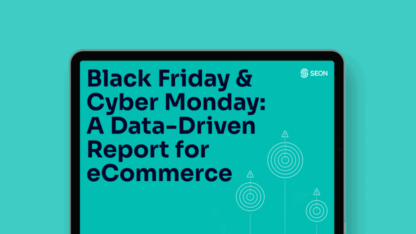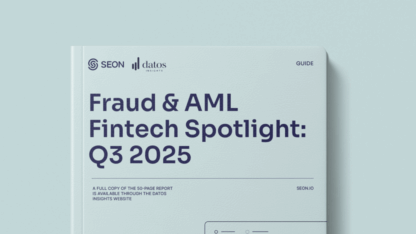Best BioCatch Alternatives
| Company | Core Features | Notable Clients | Summary |
| SEON |
| Revolut, Air France, Kindred | Unique in-depth customer profiling and flexible rules with a free plan and AML module |
| Kount |
| New Balance, Staples, Wyze Labs | Strong and secure fraud platform |
| Sift |
| Doordash, Hello Fresh, Zoosk | Single solution product to cover all AML concerns |
| ThreatMetrix (LexisNexis) |
| TripAdvisor, TD Bank, GoPro | On-premise or cloud-based FI risk management |
| Auth0 |
| Mazda, Sharp, Pfizer | Comprehensive authentication platform with tools for easy stack integration |
| Veriff |
| Trafi, Blair, Wunderflats | Video-assisted ID verification tools, biometrics, assisted image capture |
What Does BioCatch Offer?
Formed in 2011, BioCatch helps its users to catch criminals using behavioral and biometric analysis. To do this, it offers four modules: the BioCatch Rule Manager, Analyst Station, Case Manager and Policy Manager. With 2,000 parameters analyzed by its behavior analytics, BioCatch is particularly useful to customers who are looking to catch criminals using advanced emulators.
BioCatch works by creating a unique profile for each user based on about 20 unique signals that they provide, which the tool is able to use to spot whether someone is a potential criminal or not. These signals include how a customer uses their device, as well as the kinds of actions they take on the site.
BioCatch is stackable with other modules that handle KYC, IDV and other fraud prevention and detection products, meaning that if BioCatch doesn’t have everything you’re looking for, you can combine it with other tools for greater defense. Customers also vouch for its frictionless approach to authentication, making biometric verification an additional qualifier rather than requiring it from every customer.
Why Look for a BioCatch Alternative?
Even though BioCatch is stackable with other options on the market, this might not be feasible to every customer as BioCatch is expensive as a standalone tool. Indeed, the company’s website is geared towards enterprise-level businesses who have a considerable budget and need for dealing with scaled bot attacks.
If you’re a smaller company looking for something more scalable with your growth, it might be best to look at some of the other alternatives on the market.
Problems with Just Using Biometric Data
Behavioral biometrics is a technology for authenticating users based on their behavior patterns. It identifies unique, individual characteristics in how people type and interact with their mobile devices or computers, like keystroke dynamics and cursor movement.
While that sounds impressive most people interact with their phones differently in numerous scenarios e.g. sitting down, drinking a coffee or switching hands making it less accurate at identifying genuine users in detecting fraud. Other issues that arise are common with biometrics are:
- Vulnerable to spoofing
- Not as Accurate Fraud Pattern Recognition
- Lacks Device Adaptability
- Intrusive & not Privacy-Friendly
SEON’s velocity rules can detect signs of automated bot attacks
Ask an Expert
Six BioCatch Alternatives
Not sure that BioCatch is right for you? Or are looking to stack it with other software? Here are six alternatives that might be a better fit as a fraud solution.
SEON
Tamas Kadar and Bence Jendruszak had the idea for SEON when they needed a fraud prevention and detection solution for their old startup, but couldn’t find anything on the market that was just right.
SEON’s reverse email and phone lookup tool means that it’s unique in its ability to draw data from alternative sources like over 90+ social media platforms – providing customers with a more well-rounded picture of customer digital footprints. Each user is provided with a risk score based on this footprint, which can be used to either block a customer or help you decide whether further verification is needed.
This data enrichment tool is incredibly flexible in that it can be used manually as well as via browser extension, API calls and automated as part of SEON’s fraud prevention and detection solution. It aims to reduce friction and therefore churn by helping companies to catch criminals before they even have a chance to make a transaction.
Like BioCatch, SEON also has behavioral analytics capabilities. This means that SEON is able to detect potentially suspicious behavior just from a customer completing actions on your website.
If you have regulatory requirements, particularly pertaining to AML (anti-money laundering), SEON also offers a module that lets you input names manually or via API to check the relevant lists.
SEON is a more comprehensive option than BioCatch and even comes with a free tier option. It might be better for some users looking for behavioral analytics without any additional biometric analysis that might be suited to companies dealing with advanced emulators and account takeover fraud (ATO).
Kount
Kount provides an arsenal of fraud prevention and detection tools known as Kount Command, Kount Control and Kount Central. Kount Command uses AI and machine learning to analyze a customer’s action, providing them with a risk score known as an OmniScore. It compares customer data in real-time to that of previous interactions stored on the Identity Trust Global Network.
Kount Control, on the other hand, aims to prevent card testing, credential stuffing and bot attacks. It provides additional friction to suspicious customers via multi-factor authentication, and it generates reports on the basis of factors like suspicious IP addresses, failed logins and compromised accounts.
Finally, Kount Central is aimed more at payment providers looking to prevent fraudulent merchant behavior, as well as protect their merchants. Again, Kount provides users with an OmniScore which shows how suspicious a customer is.
On the whole, Kount is perhaps a better option if you’re looking to handle a large number of returns. That’s because this fraud prevention tool deals with chargeback risks, friendly fraud, gift card fraud/coupon fraud and BOPIS fraud. It’s particularly well equipped for customer-based fraud and will hopefully help you reduce the quantity of chargebacks that you experience if you’re a merchant.
If you’re not an ecommerce site or payment provider however, Kount probably won’t be suitable for you. It also uses data taken from databases to aid its decision-making which means it’s not live – you might find this data is actually stale and so not relevant anymore.
Sift
Formed in 2011 by renowned technology startup accelerator Y Combinator, Sift offers a suite of tools which seamlessly integrate with each other to detect and prevent fraud.
Its stack includes Payment Protection, Content Integrity, Account Defense, Passwordless Authentication, and Dispute Management. This means that it covers a wide range of bases like chargeback fraud, promo abuse, ToC violations, transfer fraud, and account takeover.
Because of its ability to detect promo abuse and ToC violations, Sift is worth looking at if you’re an iGaming site looking to stop fraudsters from abusing promo offers or game rules. It’s also a more than applicable option to ecommerce sites because of its chargeback dispute management platform and payment protection option.
Customers enjoy using Sift because its monitoring console is easy to use. It’s particularly useful overall if you need a fraud prevention and detection option capable of analyzing large quantities of data. Sift only introduces friction when it’s necessary, meaning that customer experience remains smooth.
Sift also offers orchestration tools designed to give fraud managers more flexibility when it comes to testing their worlfklow, and Sift Connect, designed to integrate Sift with third-party payment solutions such as Ayden, Braintree and Stripe.
However, you might find Sift lacking if you want to integrate it with other competitors. Therefore, if you want a product to integrate with BioCatch rather than a full replacement, Sift might not be the best choice for you at this point.
ThreatMetrix (LexisNexis)
The ThreatMetrix suite was acquired by data giant LexisNexis in 2012. It still remains one of the oldest transaction fraud and identity fraud prevention tools on the market to date. ThreatMetrix has access to one of the largest databases on the market, covering 78 billion data records that it’s gathered since its origins in 2005.
Using this database to provide a unique digital footprint for each customer, ThreatMatrix detects and mitigates risky user transactions and actions, stopping them before they’re able to do real harm. It does this by gathering a user’s location, device, identity and past behavior, usually in real-time alongside a transaction.
ThreatMetrix is integrable with other LexisNexis suite tools like Emailage and LexisNexis Voice Biometrics. LexisNexis can also send engineers to your site in order to integrate and optimize ThreatMetrix with your current system, making it particularly user-friendly if you’re looking to buy into the LexisNexis suite.
This makes the tool useful if you’re an ecommerce site looking for protection at the transactional level. Their focus on transaction fraud and identity fraud also means that they’re a popular choice for iGaming and financial services sites.
That being said, ThreatMetrix does not offer a free trial, which means it could be worth testing out other options first before you decide. It also don’t offer data enrichment as part of this particular solution, as you’ll have to purchase even more LexisNexis products in order to get a more well-rounded picture of your customers.
Auth0
Auth0 works to provide quality ID and authentication solutions to its customers. Its goal is to create one product which deals with a range of issues, which makes it an ideal solution if you’re looking for something versatile.
This company prides themselves on the fact that its tool produces minimal friction along the customer journey. It does this by providing single sign-on (SSO), passwordless authentication and universal login, as the idea is to reduce churn across the entire customer experience.
Selling itself as a solution to financial services, healthcare, retail, public sector and non-profits, Auth0 offers a range of different discounts and packages depending on the needs of your organization. This includes secure patient portals for healthcare companies, as well as improved security for citizen services and other digital government facilities.
Auth0 is therefore worth considering if you’re a company that has specific customer safety requirements. Pricing options range from a free plan for up to 7,000 users, plus tiers for B2C essentials, B2C professional, and enterprise.
Some customers might find Auth0 lacking in that it does not offer a full fraud prevention and detection suite. You might have to combine it with further data enrichment tools on the market in order to build a more conclusive picture of your users or customers.
Veriff
Veriff is another customer identity verification tool, formed in 2015. With its focus on ID verification, it’s able to process a broad range of documentation like passports, driving licenses and other documents across 45 different languages and dialects.
Alongside this, Veriff also comes with anti money laundering (AML) screening, assisted image capture and biometric authentication. With the help of assisted image capture in particular, you’re less likely to add friction to the customer journey as the technology reduces the number of failed facial recognition scans.
Veriff claims that, because of its accuracy, it keeps the customer journey smooth and free from friction. This leads to better onboarding processes, and therefore customer satisfaction.
Aimed at fintech, metaverse, education, healthcare, iGaming, crypto, and HR management, Veriff is potentially appealing to a wide range of companies looking to stay compliant with Know Your Customer and Anti-Money Laundering regulations in their country.
What are the limitations of Veriff? Some customers found its UI a little unintuitive. Also, another user thought that the flow customization could be improved. They also believed that Veriff’s ticketing system could be more streamlined.
Partner with SEON to reduce fraud rates in your business with real-time data enrichment, whitebox machine learning, and advanced APIs.
Ask an Expert
How to Choose the Right BioCatch Alternative
As you can see from the above, there are plenty of alternatives to BioCatch to choose from. However, you still might be thinking that BioCatch just fits your needs better. Either way, we hope that you’re now better informed when you come to choose the product that best suits you.
Ultimately, it’s best to go with whatever option covers your needs most specifically. When making the final call, make sure you know your own organization’s needs, goals, and appetites, and narrow down products based on those criteria.
BioCatch Alternatives FAQ
BioCatch is one of the more expensive tools on the market, meaning that it’s probably better to go with them if you’re certain that it meets your requirements. That being said, BioCatch is well respected as an advanced tool for tackling emulators and similar threats. However, if you’re not so concerned about dealing with these kinds of attacks, there are plenty of free trials and tier options available from the alternatives provided above.
If you want to learn more about BioCatch, you can do so by reading our guide to SEON vs BioCatch. Also visit G2 and Capterra if you’re looking for more user reviews and experiences to help aid your final decision.
Learn more about:
Sift Alternatives | Kount Alternatives | Feedzai Competitors | Threatmetrix Alternatives | Emailage Competitors








